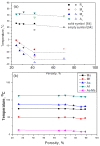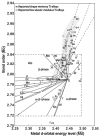Biomedical Porous Shape Memory Alloys for Hard-Tissue Replacement Materials
- PMID: 30217097
- PMCID: PMC6164106
- DOI: 10.3390/ma11091716
Biomedical Porous Shape Memory Alloys for Hard-Tissue Replacement Materials
Abstract
Porous shape memory alloys (SMAs), including NiTi and Ni-free Ti-based alloys, are unusual materials for hard-tissue replacements because of their unique superelasticity (SE), good biocompatibility, and low elastic modulus. However, the Ni ion releasing for porous NiTi SMAs in physiological conditions and relatively low SE for porous Ni-free SMAs have delayed their clinic applications as implantable materials. The present article reviews recent research progresses on porous NiTi and Ni-free SMAs for hard-tissue replacements, focusing on two specific topics: (i) synthesis of porous SMAs with optimal porous structure, microstructure, mechanical, and biological properties; and, (ii) surface modifications that are designed to create bio-inert or bio-active surfaces with low Ni releasing and high biocompatibility for porous NiTi SMAs. With the advances of preparation technique, the porous SMAs can be tailored to satisfied porous structure with porosity ranging from 30% to 85% and different pore sizes. In addition, they can exhibit an elastic modulus of 0.4⁻15 GPa and SE of more than 2.5%, as well as good cell and tissue biocompatibility. As a result, porous SMAs had already been used in maxillofacial repairing, teeth root replacement, and cervical and lumbar vertebral implantation. Based on current research progresses, possible future directions are discussed for "property-pore structure" relationship and surface modification investigations, which could lead to optimized porous biomedical SMAs. We believe that porous SMAs with optimal porous structure and a bioactive surface layer are the most competitive candidate for short-term and long-term hard-tissue replacement materials.
Keywords: NiTi; biocompatibility; porous material; shape memory alloy; surface modification; β type Ni-free Ti alloy.
Conflict of interest statement
The authors declare no conflict of interest.
Figures















































Similar articles
-
Porous NiTi for bone implants: a review.Acta Biomater. 2008 Jul;4(4):773-82. doi: 10.1016/j.actbio.2008.02.009. Epub 2008 Feb 23. Acta Biomater. 2008. PMID: 18348912 Free PMC article. Review.
-
Porous NiTi shape memory alloys produced by SHS: microstructure and biocompatibility in comparison with Ti2Ni and TiNi3.J Mater Sci Mater Med. 2014 Oct;25(10):2277-85. doi: 10.1007/s10856-014-5253-x. Epub 2014 Jun 14. J Mater Sci Mater Med. 2014. PMID: 24928669
-
The Influence of Ultrasonic Activation on Microstructure, Phase Transformation and Mechanical Properties of Porous Ni-Ti Shape Memory Alloys via Self-Propagating High-Temperature Synthesis.Materials (Basel). 2023 Sep 9;16(18):6134. doi: 10.3390/ma16186134. Materials (Basel). 2023. PMID: 37763412 Free PMC article.
-
A comparative study of the cytotoxicity and corrosion resistance of nickel-titanium and titanium-niobium shape memory alloys.Acta Biomater. 2012 Jul;8(7):2863-70. doi: 10.1016/j.actbio.2012.03.034. Epub 2012 Mar 28. Acta Biomater. 2012. PMID: 22465573
-
A new look at biomedical Ti-based shape memory alloys.Acta Biomater. 2012 May;8(5):1661-9. doi: 10.1016/j.actbio.2012.01.018. Epub 2012 Jan 28. Acta Biomater. 2012. PMID: 22326786 Review.
Cited by
-
Large Cyclability of Elastocaloric Effect in Highly Porous Ni-Fe-Ga Foams.Materials (Basel). 2024 Mar 9;17(6):1272. doi: 10.3390/ma17061272. Materials (Basel). 2024. PMID: 38541426 Free PMC article.
-
Toward Fully Automated Personalized Orthopedic Treatments: Innovations and Interdisciplinary Gaps.Bioengineering (Basel). 2024 Aug 12;11(8):817. doi: 10.3390/bioengineering11080817. Bioengineering (Basel). 2024. PMID: 39199775 Free PMC article. Review.
-
Theoretical Study on the Structural, Mechanical, Thermodynamic, and Vibrational Properties of Ti8Ni8-x Fe x (X = 0-8) Shape Memory Alloys for Biomedical Applications.ACS Omega. 2025 Apr 30;10(18):18303-18311. doi: 10.1021/acsomega.4c08953. eCollection 2025 May 13. ACS Omega. 2025. PMID: 40385209 Free PMC article.
-
Effect of Nanopores on Mechanical Properties of the Shape Memory Alloy.Micromachines (Basel). 2021 May 7;12(5):529. doi: 10.3390/mi12050529. Micromachines (Basel). 2021. PMID: 34067037 Free PMC article.
-
Significant advancements of 4D printing in the field of orthopaedics.J Clin Orthop Trauma. 2020 Jul;11(Suppl 4):S485-S490. doi: 10.1016/j.jcot.2020.04.021. Epub 2020 Apr 25. J Clin Orthop Trauma. 2020. PMID: 32774016 Free PMC article.
References
-
- World Population Prospects 2017. Population Division, DESA, United Nations; New York, NY, USA: 2017.
-
- Wise D.L. Biomaterials Engineering and Devices. Humana Press; Berlin, Germany: 2000. pp. 205–319.
-
- Park J.B., Bronzino J.D. Biomaterials: Principles and Applications. CRC Press; Boca Rator, FL, USA: 2003. pp. 1–241.
-
- Geetha M., Singh A.K., Asokamani R., Gogia A.K. Ti based biomaterials, the ultimate choice for orthopaedic implants–A review. Prog. Mater. Sci. 2009;54:397–425. doi: 10.1016/j.pmatsci.2008.06.004. - DOI
Publication types
Grants and funding
- 51571090/National Natural Science Foundation of China
- 51621001/Innovative Research Groups of the National Natural Science Foundation of China
- 2017B030308001/Training Program of Major Basic Research Project of Provincial Natural Science Foundation of Guangdong
- 2017ZD009/the Fundamental Research Funds for the Central Universities
LinkOut - more resources
Full Text Sources
Other Literature Sources
Research Materials

